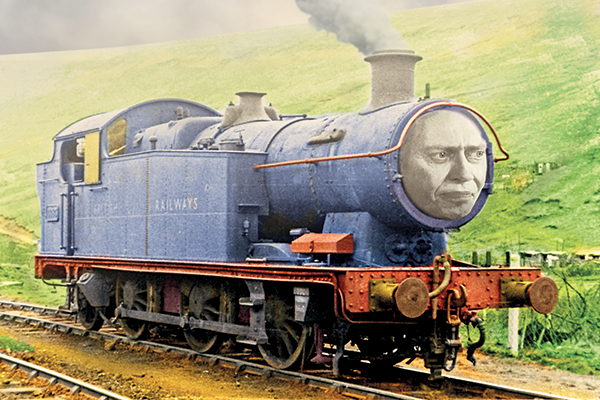This Train Carries Lost Souls
Children’s Classic Given a Dark New Life
The film has a Dunedin connection: Sean Baker-Haines, a Dunedin local and University of Otago graduate, has a minor role as Jones, an engineer. This was Baker-Haines’ first acting role, having worked as a production assistant on various sets since graduating, and Critic caught up with him for a chat.
Baker-Haines describes the experience of working on Thomas as “humbling … Darren [Aronofsky] has always been one of my heroes, so getting to not only meet him but work with him too was incredible.
“He’s a visionary who’s really breathed new life into these much-loved characters. A lot of people have been criticising how dark the film is, but that’s the way movies are going these days. Darren’s bringing the sensibilities he showed in films like Requiem for a Dream and Black Swan and applying them to this new context in a way that’s really exciting.”
The film is certainly dark. Thomas (Steve Buscemi), an anthropomorphic steam engine, has fallen far from the cheerful locomotive he once was, and is now brooding and introspective. Facing increasing competition from bullet trains and other forms of electric rail, Thomas feels that his existence is under threat. This leads him to reflect on the meaninglessness of his life, a life rigidly bound to the British railway system and the coaches he is forced to pull across it. He considers himself a slave to the rails and the carriages, and yearns to roll free through the roads and meadows. But it is not to be.
“Thomas is at an interesting point in his life where he’s really starting to question his life choices and where people are starting to see him differently,” Baker-Haines says. “I think they’ve really pulled off a coup getting Steve on board to play him – he’s a perfect fit.” Indeed, Buscemi’s hangdog features and sunken eyes might not be everybody’s cup of tea, but he undeniably puts a fascinating, doleful new spin on the iconic character. His is a Thomas worn down by decades of shunting, freighting, and inhalation of smoke and steam.
In a last-ditch attempt to retain his relevance, Thomas gives in to the Fat Controller’s radical plan to turn him into a mobile high-class brothel. The Fat Controller – an almost unrecognisable James Franco, who donned a fat suit and heavy prosthetics for the part – is an unstable and terrifying presence, driven by an all-consuming desire to “control everything.” Franco took on the role in order to “show his range,” and has already been heavily tipped for next year’s Oscars.
Thomas develops feelings for a monorail named Cindy, who is herself in the midst of an existential crisis. Cindy (Kristen Schaal) is unable to shake the feeling that she is “not real public transport,” and is simply an expensive marketing gimmick by a local government with too much cash to spare. The two bond over their mutual insecurities, but their budding romance is thrown into jeopardy when Thomas contracts gonorrhea and syphilis after having sex with Space Mountain.
Although Jones is a small part, Baker-Haines says he has an important part to play in the story. “Jones really comes to the fore after Thomas contracts those diseases – he’s really important in terms of looking after Thomas, making sure he keeps running properly and that he uses only clean coal, not lignite. … In a way he’s Thomas’ closest companion – he’s not so much by Thomas’ side as he is physically inside him, all the time.”
As the railway increasingly sheds customers to Noddy’s taxi service, the Fat Controller turns to one of his new brothel’s most violent and psychopathic patrons, Postman Pat (Sean Penn), to bring the failing business out of the red. Postman Pat and his black and white feral cat stalk the streets in search of Noddy (Elijah Woods). Noddy, having been framed by the corrupt policeman Mr. Plod (Paul Giamatti) for fatally running down Skippy the bush kangaroo, takes refuge in Thomas’ mobile brothel. This sets the film up for a spectacularly tense set piece, as Plod, Pat and Noddy square off inside Thomas’ plush and seedy carriages.
That scene, which pays homage to such films as From Russia With Love, was Baker-Haines’ favourite to shoot. “It was brilliant, I’ve seen a lot of action scenes get shot before, but it was great to finally get in front of the camera and get to take part myself,” he enthuses. “It shows a new side to a lot of these characters – most people probably don’t think of Postman Pat as someone who’s capable of these really brutal acts of gratuitous violence, but that’s what you get in this film.”
But is the film too dark? During a recent interview, Buscemi reflected that the screenplay had “perhaps strayed too far” from the source material and had become too heavy. “I probably would have liked Joel and Ethan [Coen] to write it, but they were busy,” he said. Buscemi cited the moment when Thomas passes on his syphilis to Cindy as an example of this tendency. “That’s just not something children will understand or appreciate,” he predicted, “especially when Cindy goes mad from the syphilis and crashes into a multiplex.” The crash causes hundreds of fatalities, almost driving Thomas over the edge.
Baker-Haines disagrees that the film’s moodiness goes too far. “At the end of the day it probably transcends that kids-film genre into something more approaching art,” he reasons. “It’s pitched more at people who grew up with these characters, who love them dearly and hold really fond memories, and making a film about what would happen if everything suddenly became really harrowing and traumatic.
“Hopefully it makes people just reflect a little bit on their childhood, and maybe replace those superficially happy memories they used to have with something a bit more grim and troubling.”



